SREBP Coordinates Iron and Ergosterol Homeostasis to Mediate Triazole Drug and Hypoxia Responses in the Human Fungal Pathogen
Sterol regulatory element binding proteins (SREBPs) are a class of basic helix-loop-helix transcription factors that regulate diverse cellular responses in eukaryotes. Adding to the recognized importance of SREBPs in human health, SREBPs in the human fungal pathogens Cryptococcus neoformans and Aspergillus fumigatus are required for fungal virulence and susceptibility to triazole antifungal drugs. To date, the exact mechanism(s) behind the role of SREBP in these observed phenotypes is not clear. Here, we report that A. fumigatus SREBP, SrbA, mediates regulation of iron acquisition in response to hypoxia and low iron conditions. To further define SrbA's role in iron acquisition in relation to previously studied fungal regulators of iron metabolism, SreA and HapX, a series of mutants were generated in the ΔsrbA background. These data suggest that SrbA is activated independently of SreA and HapX in response to iron limitation, but that HapX mRNA induction is partially dependent on SrbA. Intriguingly, exogenous addition of high iron or genetic deletion of sreA in the ΔsrbA background was able to partially rescue the hypoxia growth, triazole drug susceptibility, and decrease in ergosterol content phenotypes of ΔsrbA. Thus, we conclude that the fungal SREBP, SrbA, is critical for coordinating genes involved in iron acquisition and ergosterol biosynthesis under hypoxia and low iron conditions found at sites of human fungal infections. These results support a role for SREBP–mediated iron regulation in fungal virulence, and they lay a foundation for further exploration of SREBP's role in iron homeostasis in other eukaryotes.
Published in the journal:
. PLoS Genet 7(12): e32767. doi:10.1371/journal.pgen.1002374
Category:
Research Article
doi:
https://doi.org/10.1371/journal.pgen.1002374
Summary
Sterol regulatory element binding proteins (SREBPs) are a class of basic helix-loop-helix transcription factors that regulate diverse cellular responses in eukaryotes. Adding to the recognized importance of SREBPs in human health, SREBPs in the human fungal pathogens Cryptococcus neoformans and Aspergillus fumigatus are required for fungal virulence and susceptibility to triazole antifungal drugs. To date, the exact mechanism(s) behind the role of SREBP in these observed phenotypes is not clear. Here, we report that A. fumigatus SREBP, SrbA, mediates regulation of iron acquisition in response to hypoxia and low iron conditions. To further define SrbA's role in iron acquisition in relation to previously studied fungal regulators of iron metabolism, SreA and HapX, a series of mutants were generated in the ΔsrbA background. These data suggest that SrbA is activated independently of SreA and HapX in response to iron limitation, but that HapX mRNA induction is partially dependent on SrbA. Intriguingly, exogenous addition of high iron or genetic deletion of sreA in the ΔsrbA background was able to partially rescue the hypoxia growth, triazole drug susceptibility, and decrease in ergosterol content phenotypes of ΔsrbA. Thus, we conclude that the fungal SREBP, SrbA, is critical for coordinating genes involved in iron acquisition and ergosterol biosynthesis under hypoxia and low iron conditions found at sites of human fungal infections. These results support a role for SREBP–mediated iron regulation in fungal virulence, and they lay a foundation for further exploration of SREBP's role in iron homeostasis in other eukaryotes.
Introduction
Fungal pathogens face numerous environmental challenges during growth in mammalian hosts that can determine outcomes of host-pathogen interactions. A major factor in host defense against invading fungi is the sequestration of iron, which prevents in vivo fungal growth [1]. Consequently, most fungal pathogens have evolved mechanisms to obtain iron from their hosts and these mechanisms are established fungal virulence attributes [2], [3], [4], [5], [6], [7], [8]. Intriguingly, an association between responses to iron and oxygen limitation emerged from studies in rodents demonstrating increased iron absorption in response to hypoxia [9]. Moreover, hypoxia is known to increase the expression of transferrin, which increases iron availability to host cells under hypoxic stress [10]. The key transcriptional regulator of mammalian responses to hypoxia, hypoxia inducible factor-1 (HIF), has been found to regulate several genes involved in iron metabolism [11], [12], [13], [14]. Thus, an intimate link exists between cellular responses to low oxygen environments and iron availability in eukaryotes. Yet, mechanisms of regulation of this potential link in human pathogenic fungi are largely unknown.
Previous results strongly suggest that mechanisms of both iron acquisition and hypoxia adaptation are critical for fungi to cause disease in humans. Strains of the human fungal pathogen Aspergillus fumigatus that no longer make any iron-sequestering siderophores are fully avirulent, while strains deficient in either extracellular or intracellular siderophore production display attenuated virulence [4], [5], [6]. Regulation of iron acquisition in A. fumigatus and other fungi that make siderophores is mediated by two key transcription factors SreA and HapX [2], [15]. Null mutants of SreA display increased siderophore production and as expected remain fully virulent in animal models of invasive pulmonary aspergillosis. Conversely, null mutants of HapX have a reduced ability to produce siderophores and are consequently significantly attenuated in virulence. Recently, a third transcription factor, AcuM, has been hypothesized to repress SreA and transcriptionally induce HapX via transcriptome profiling experiments [16]. Though it is unclear if the effects of AcuM on SreA and HapX are indirect or direct, AcuM null mutants have decreased siderophore production and attenuated virulence [16]. Data from these studies strongly suggest the presence of additional unidentified regulators of iron metabolism in fungi.
An appreciation for the involvement of hypoxia in fungal pathogenesis is recent and strongly supported by characterization of fungal sterol regulatory element binding protein (SREBP) null mutants that are incapable of growth in hypoxia, attenuated in fungal virulence, and more susceptible to triazole antifungal drugs [17], [18], [19], [20], [21], [22]. SREBPs are a unique family of membrane bound basic helix-loop-helix (bHLH) transcription factors that mediate a diverse array of biological processes in eukaryotic organisms [23]. In mammals, SREBPs have been observed to regulate cholesterol, lipid, and carbohydrate metabolism whereas in cholesterol auxotrophs such as Drosophila melanogaster and Caenorhabditis elegans SREBPs function to regulate fatty acid biosynthesis and development [24], [25], [26], [27], [28]. In Schizosaccharomyces pombe and Cryptococcus neoformans, SREBPs transcriptionally regulate genes involved in responses to low oxygen with the ergosterol biosynthesis pathway being an important downstream effector [17], [18], [29], [30]. A preliminary characterization of the A. fumigatus SREBP affected transcriptome adds further support to the conclusion that fungal SREBPs are key transcriptional regulators of ergosterol biosynthesis [19]. Yet, the key SREBP mediated downstream effectors in A. fumigatus remain to be fully elucidated. Discovering the SREBP mediated regulon in A. fumigatus and other human pathogenic fungi is critical for fully understanding the role of this transcriptional regulator in fungal pathogenesis.
In this study, we utilized microarray-based transcriptomics and molecular genetics to further define the role of the SREBP SrbA in A. fumigatus. We report that in A. fumigatus SrbA is an unidentified regulator of iron homeostasis. Additionally, we observe that SrbA's role in iron metabolism is intimately linked with SrbA's previously identified role in hypoxia adaptation and triazole drug susceptibility. Together, these results advance our understanding of regulation of fungal iron homeostasis and provide new evidence for understanding the role of fungal SREBPs in fungal virulence, hypoxia adaptation, and antifungal drug susceptibility.
Results
Hypoxia Transcriptome analysis of the A. fumigatus SREBP null mutant reveals downstream effectors associated with ergosterol biosynthesis and iron acquisition
Previously, we reported that loss of the SREBP, SrbA, in the human fungal pathogen A. fumigatus resulted in loss of hypoxia growth, increased susceptibility to triazole antifungal drugs, and a significant attenuation in virulence [19]. To better understand the mechanisms of the previously observed SrbA dependent clinically relevant phenotypes, we sought to identify potential SrbA downstream effectors in A. fumigatus. We compared whole genome transcript level profiles of wild-type and the SREBP null mutant, ΔsrbA, in response to hypoxia (1% O2, 5% CO2, 94% N2). Because ΔsrbA cannot grow in hypoxia, a shift experiment was done whereby both strains were grown in normoxic conditions to the germling stage, then shifted to hypoxia conditioned media for defined time points. Transcriptome profiles at 1, 2, and 4 hours post exposure to hypoxia were measured with microarrays and reveal dramatic changes in the fungal transcriptome due to loss of SrbA activity (Tables S1, S2, S3, S4, S5, S6 and Figure 1). At one-hour post exposure to hypoxia, levels of mRNA from 639 genes were reduced ≥2 fold in the absence of SrbA (6.5% of the genome) (Table S1). mRNA from an additional 524 genes was increased ≥2 fold due to absence of SrbA (5.3% of the genome) (Table S2). Thus, upon initial exposure to hypoxia, approximately 12% of A. fumigatus genes are affected by SrbA activity. At 2 hours post-exposure to hypoxia, the number of mRNAs whose abundance decreased ≥2 fold increased to 773 (Table S3) and the number of mRNAs whose abundance increased ≥2 fold increased to 727 (Table S4). Finally, at 4 hours post-exposure to hypoxia, 602 mRNAs remained transcriptionally decreased ≥2 fold (Table S5) while 667 mRNAs remained ≥2 fold transcriptionally increased (Table S6). Manual gene ontology analysis as well as Gene set enrichment analysis (GSEA) of available GO terms suggested an SrbA dependency for ergosterol biosynthesis, iron acquisition, glycolysis, ribosome biogenesis, and amino acid biosynthesis (Figure S1, S2, S3; Tables S7, S8, S9). Taken together, these results suggest that SrbA is a major transcriptional regulator in A. fumigatus that may act as both a positive and negative regulator of transcription.
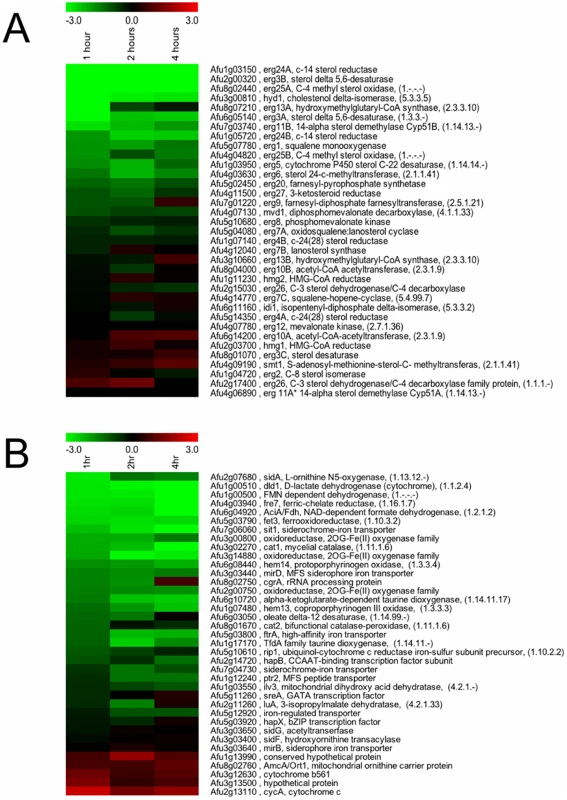
Previous studies in S. pombe, C. neoformans, and A. fumigatus strongly suggested that fungal SREBPs are key regulators of ergosterol biosynthesis. Thus, not surprisingly, levels of mRNAs encoding Erg24, Erg3, and Erg25A were all at least 20 fold less abundant at one hour post-exposure to hypoxia in the absence of SrbA (Figure 1A, Table S1). The levels of mRNA from these genes remained substantially reduced at 2 and 4 hours and confirm our previously reported sterol profiles of the SrbA null mutant that demonstrated a partial block in ergosterol biosynthesis at the level of C4-demethylation [19]. In addition, and in contrast to our previously published analysis of a 24 hour time point transcriptome, levels of mRNA from several key genes encoding enzymes involved in iron homeostasis were found to be reduced at least 6 fold in the absence of SrbA (Figure 1B, Tables S1, S3, S5). The decrease in mRNA of genes associated with iron metabolism suggests that the initial response to hypoxia of A. fumigatus involves transcriptional induction of genes involved in iron acquisition. This result supports previous studies in mammals that demonstrate a tight link between hypoxia adaptation and iron homeostasis. In A. fumigatus, mRNA levels of sidA, an L-ornithine monooxygenase that catalyzes the first step in siderophore biosynthesis were reduced in the absence of SrbA (Figure 1B and Figure 2). Reduction in sidA mRNA levels would be expected to decrease both extracellular and intracellular siderophore production in A. fumigatus. mRNA from other genes involved in iron acquisition were also less abundant in the absence of SrbA including, the siderophore transporters mirB and sit1, the high affinity iron transporter ftrA, and the ferrooxidoreductase fetC involved in reductive iron assimilation. We further confirmed the SrbA dependency for transcription of iron associated genes in response to hypoxia utilizing qRT-PCR (Figure 2). At 1, 2, and 4 hours, exposure to hypoxia reduced transcript levels of fetC, sidA, and sit1 in the absence of SrbA. Transcript levels of ftrA were SrbA dependent at 1 hour post-exposure to hypoxia, but increased at 2 and 4 hours via an unknown mechanism. Taken together, these results suggest that SrbA is a critical regulatory factor for iron homeostasis during the initial response to hypoxia.
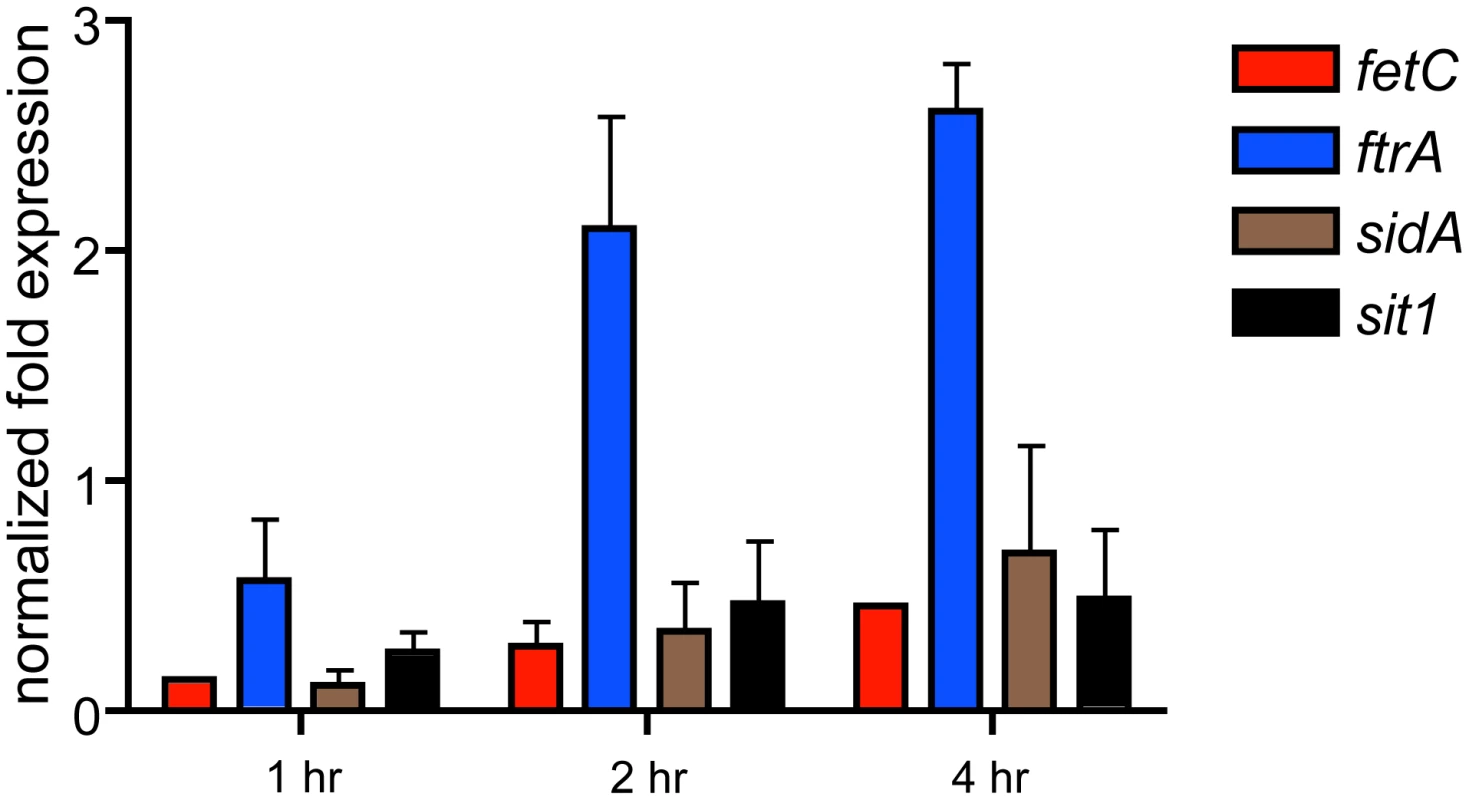
We next asked the question whether SrbA directly or indirectly regulated transcriptional regulation of ergosterol biosynthesis and iron acquisition. Wild-type and ΔsrbA strains were cultivated as for the microarray and qRT-PCR experiments, and at 4 hours post-exposure to hypoxia chromatin immunoprecipitation (ChIP) was performed using IgG and polyclonal SrbA (amino acids 1–275) antibodies. Immunoprecipitated DNA was quantified for erg25A, erg11A, sit1, and sidA using primers targeted to the promoter regions of these genes. Significant enrichment for SrbA binding to the promoters of erg11A, erg25A, and sit1, was observed indicating that SrbA likely directly binds to the promoters of these genes (Figure 3). However, no enrichment was observed for sidA indicating that SrbA regulation of this important siderophore biosynthesis gene may be indirect. Taken together, these results strongly suggest that SrbA coordinately regulates ergosterol biosynthesis and iron uptake in response to hypoxia.
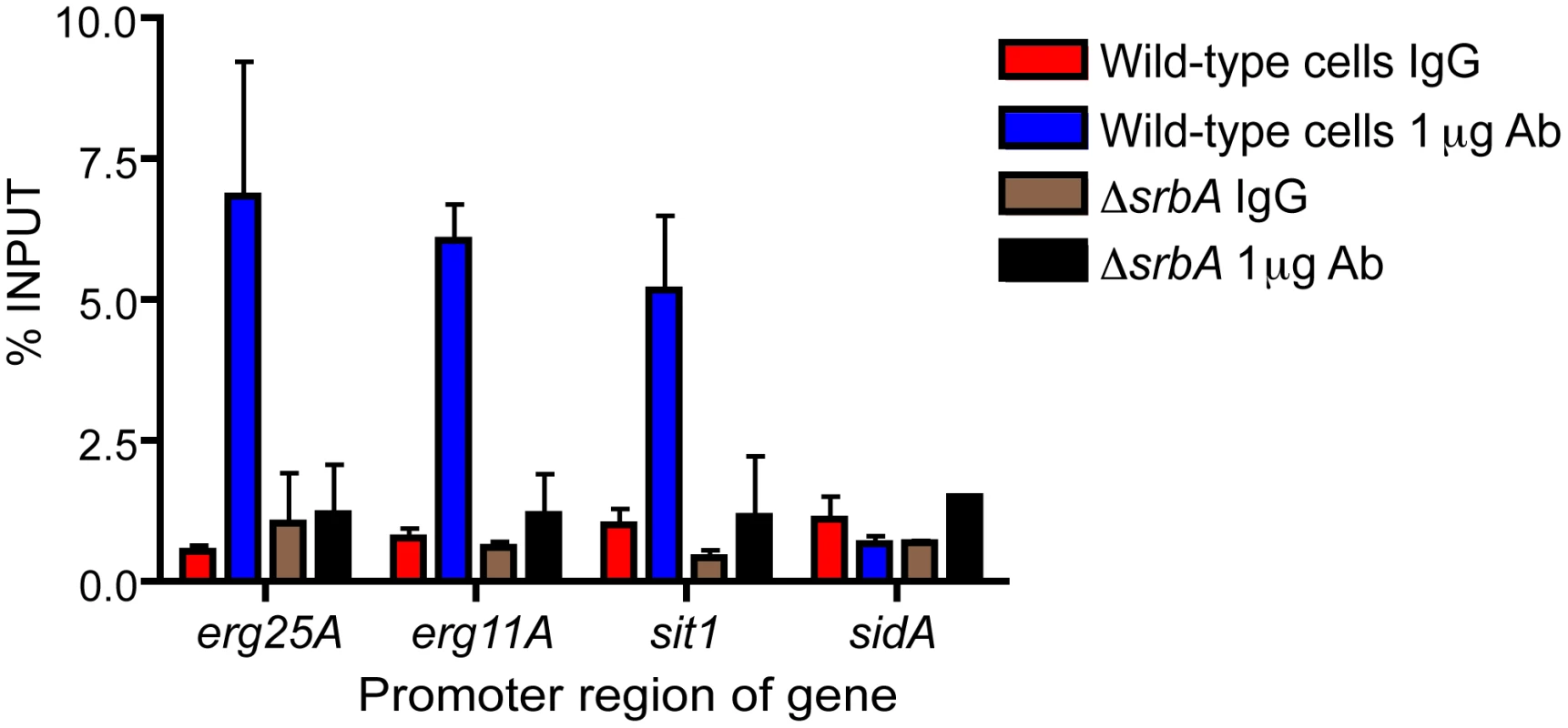
SrbA-deficiency impairs submersed growth during iron starvation due to iron shortage
Because iron is a critical co-factor for enzymes involved in ergosterol biosynthesis, we explored the hypothesis that SrbA is a positive regulator of iron acquisition independent of the known fungal iron regulators SreA and HapX. In order to compare the function of SrbA with that of SreA and HapX, ΔsreA and ΔhapX mutants were generated in CEA10 and ΔsrbA backgrounds as previously described for ATCC46645 [2], [15]. We then tested the consequences of SrbA-deficiency in the generated strains in submersed liquid cultures under iron replete and iron limiting conditions. In iron replete conditions, ΔsrbA biomass was 54% (54.0/100.0) of the wild-type and in iron depleted conditions, ΔsrbA biomass diminished even further to 32% (18.52/57.47) of wild-type (Table 1). Importantly, the ΔsrbA reconstituted strain completely restored wild-type biomass in response to iron depletion indicating that the iron phenotype observed is specifically due to loss of SrbA (Table 1). Consequently, the −Fe/+Fe biomass ratio decreased from 57% (57.47/100.00) for CEA10 to 34% (18.52/54.00) for ΔsrbA (Table 1). Thus, loss of SrbA negatively affects the ability of A. fumigatus to deal with low iron environments supporting the observed transcriptional profiling data.

As expected, SreA-deficiency did not affect liquid biomass production during either iron-replete or iron-depleted conditions. Intriguingly, inactivation of SreA in the ΔsrbA strain increased fungal biomass by 47% in iron-depleted conditions and 20% in iron-replete conditions compared to the ΔsrbA strain itself. Consequently, this increased the −Fe/+Fe biomass ratio to 42% (Table 1). As found previously for A. fumigatus strain ATCC46445 [2], HapX-deficiency decreased liquid biomass production during iron starvation in A. fumigatus strain CEA10 by about 60% but had no significant effect during iron sufficiency because hapX is mainly expressed during iron starvation [2]. Compared to ΔsrbA, additional inactivation of HapX in ΔsrbA decreased the biomass by 37% in iron depleted conditions but had no effect in iron-replete conditions (Table 1). Taken together, these data strongly support the hypothesis that SrbA is required for adaptation to iron starvation independent of the known fungal iron metabolism regulators SreA and HapX.
SrbA is required for full activation of extra- and intracellular siderophore production
We next explored the mechanism behind the detrimental effects of iron starvation on ΔsrbA. Our transcriptome profiling experiments implied a potential role for SrbA regulation of siderophore biosynthesis and uptake. As shown previously for A. fumigatus strain ATCC46445 [4], [5], A. fumigatus strain CEA10 produces extracellular TAFC (triacetylfusarinine C) exclusively during iron starvation. Intriguingly, SrbA-deficiency decreased TAFC production by 90% compared to wild-type CEA10 in iron starvation conditions (Figure 4A). Similar to previous findings with A. fumigatus strain ATCC46445 [2], [15], HapX-deficiency in CEA10 decreased TAFC production during iron starvation by 79% during iron starvation while SreA-deficiency in CEA10 caused a 7% derepression of TAFC production during iron sufficiency (Figure 4A). Compared to ΔsrbA, additional deletion of hapX in ΔsrbA decreased TAFC production by 79% during iron depleted conditions (Figure 4A). In contrast, additional deletion of sreA in ΔsrbA increased TAFC production compared to ΔsrbA by 163% during iron starvation and derepressed TAFC production to 40% of the ΔsreA level during iron sufficiency (Figure 4A).
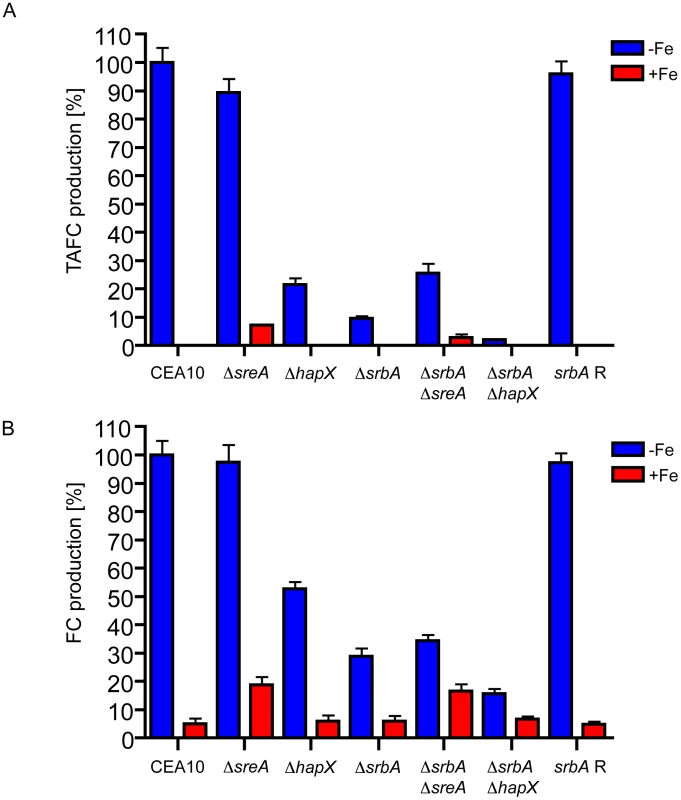
As shown previously for A. fumigatus strain ATCC46445 [4], [5], A. fumigatus strain CEA10 accumulates intracellular FC (ferricrocin) in the ferri-form during iron sufficiency and about 20 fold higher amounts in the desferri-form during iron starvation (Figure 4B). SrbA-deficiency had no effect of the FC during iron sufficiency. However, SrbA-deficiency decreased the FC content by 71% compared to CEA10 during iron starvation (Figure 4B). Similar to previous findings with A. fumigatus strain ATCC46445 [2], [15], HapX-deficiency in CEA10 decreased the FC content during iron starvation by 47% during iron starvation while SreA-deficiency in CEA10 increased the FC content during iron sufficiency 3.7 fold (Figure 4B). Compared to ΔsrbA, the FC content in ΔsrbAΔhapX is decreased by 46% during iron starvation (Figure 4B). In contrast, additional deletion of SreA in ΔsrbA increased the FC content compared to ΔsrbA by 19% during iron starvation and 181% during iron sufficiency (Figure 4B).
Together, these data indicate that SrbA activates production of extra-and intracellular siderophores independent of SreA and HapX. Moreover, this biochemical data supports the observed transcriptome profile of ΔsrbA that strongly suggests a critical role for SrbA in regulation of siderophore biosynthesis and uptake. However, the mechanism by which SrbA regulates siderophore production remains to be elucidated. As production of extra- and intracellular siderophores plays a crucial role in adaptation to iron starvation [4], [5], these data explain, at least in part, the observed growth and morphological defects of ΔsrbA during iron starvation.
srbA mRNA abundance is regulated by iron availability, and SrbA positively affects iron acquisition and biosynthesis of heme and ergosterol
In further support of SrbA's role as a positive regulator of iron homeostasis, previous genome-wide transcriptome profiling experiments indicated that srbA transcript levels are reduced within 30–60 minutes during a shift from iron starvation to iron sufficiency independent of SreA and HapX [2], [15]. Thus, we next confirmed that srbA transcript levels are substantially higher during iron starvation compared to iron sufficiency, and that srbA transcript levels are not influenced by inactivation of SreA or HapX (Figure 5). These results further support the hypothesis that SrbA transcript levels increase under low iron conditions and that this increase is independent of the known transcriptional regulators of iron homeostasis SreA and HapX.
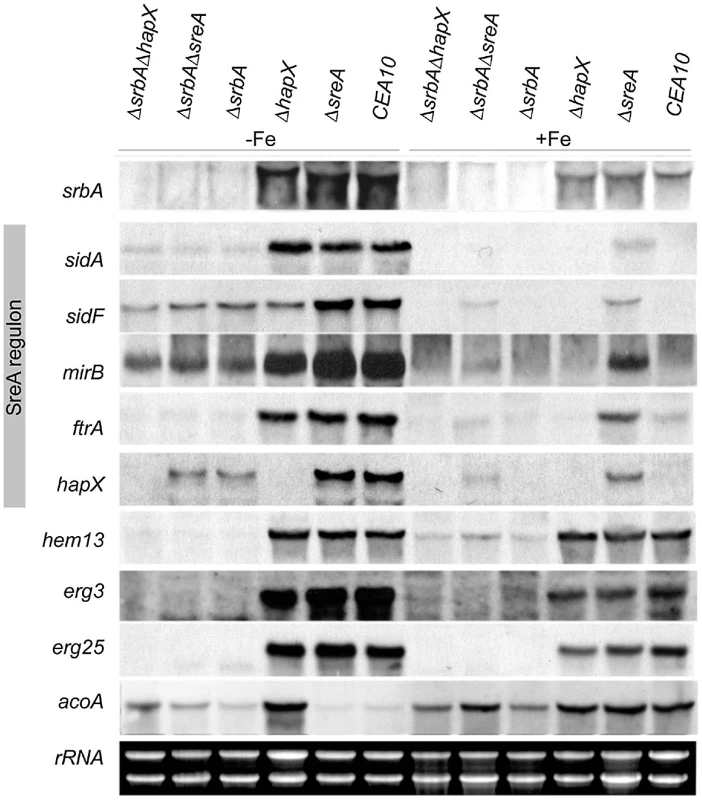
Consistent with the transcriptome profile of ΔsrbA upon early exposure to hypoxia and biochemical analysis of siderophore production in the absence of SrbA, inactivation of SrbA reduced mRNA levels of genes involved in siderophore metabolism (siderophore biosynthetic sidA, TAFC-biosynthetic sidF, and siderophore importer-encoding mirB), reductive iron assimilation (ftrA), and iron transcriptional regulation (hapX) in iron limited conditions (Figure 5). All of these genes belong to the SreA regulon [15]. Moreover, SrbA deletion decreased the degree of derepression of these genes in ΔsreA during iron sufficiency (compare ΔsreA and ΔsrbAΔsreA). The reduction of hapX mRNA levels in the absence of SrbA in iron limiting conditions suggests a previous unreported link between SrbA and HapX in iron limiting conditions. Together, these data support a role for SrbA in adaptation to iron starvation and demonstrate that SrbA impacts siderophore biosynthesis at the transcriptional level both in response to hypoxia and iron starvation through an unknown mechanism.
Importantly, mRNA levels of genes involved in ergosterol biosynthesis were also found to be more abundant under iron starvation conditions (Figure 5). Similar to the hypoxia mRNA transcriptome profiling data, this increase in mRNA levels is SrbA dependent (Figure 5). In further support of SrbA's role in regulating iron metabolism, mRNA levels of the iron center-ergosterol biosynthetic enzymes Erg3 (C-5 sterol desaturase) and Erg25 (C-4 methyl sterol oxidase) were independent of SreA and HapX (Figure 5). As mRNA levels from both erg3 and erg25 are also reduced in ΔsrbA in response to hypoxia, these data further support the SrbA mediated link between ergosterol biosynthesis and iron metabolism in response to hypoxia in A. fumigatus. Also of interest, SrbA inactivation decreased mRNA levels of the heme biosynthetic gene hem13 (encoding coproporphyrinogen III oxidase) independent of SreA and HapX in iron limited and hypoxia conditions.
Importantly, mRNA levels of acoA, which encodes the iron-sulfur cluster-containing aconitase and whose expression is subject to HapX-mediated repression during iron starvation are decreased during iron-replete conditions in ΔsrbA and ΔsrbAΔhapX but not in ΔsrbAΔsreA [2]. These data indicate that SrbA-deficiency decreases cellular iron supply during iron-replete conditions due to reduction of iron uptake. Importantly, this defect can be partially suppressed by derepression of iron uptake via SreA-deficiency (ΔsrbAΔsreA).
Increased iron availability and/or inactivation of SreA increases resistance of ΔsrbA to fluconazole and partially restores growth in hypoxia
We next explored the hypothesis that the partial suppression of decreased cellular iron supply in ΔsrbAΔsreA would rescue the clinically relevant phenotypes of ΔsrbA: increased fluconazole susceptibility, inability to grow in hypoxia, and ability to cause invasive pulmonary aspergillosis. E-test mediated fluconazole susceptibility testing confirmed our previously published results that the inherent fluconazole resistance of A. fumigatus CEA10 depends on SrbA activity (Figure 6). Fluconazole susceptibility in ΔsrbA was consistent in both iron depleted and iron replete conditions. Intriguingly, high iron conditions were able to increase the resistance of ΔsrbA against fluconazole (high iron MIC = 12 µg/ml compared to an MIC of 1 µg/ml during iron replete or iron starvation). Additional deletion of sreA, but not hapX, in ΔsrbA partially rescued fluconazole resistance, and this effect, as expected, was potentiated under high iron conditions. Importantly, deletion of either sreA or hapX alone did not affect fluconazole susceptibility. Taken together, these results suggest that the increase in A. fumigatus fluconazole susceptibility in the absence of SrbA is partially due to loss of iron homeostasis.
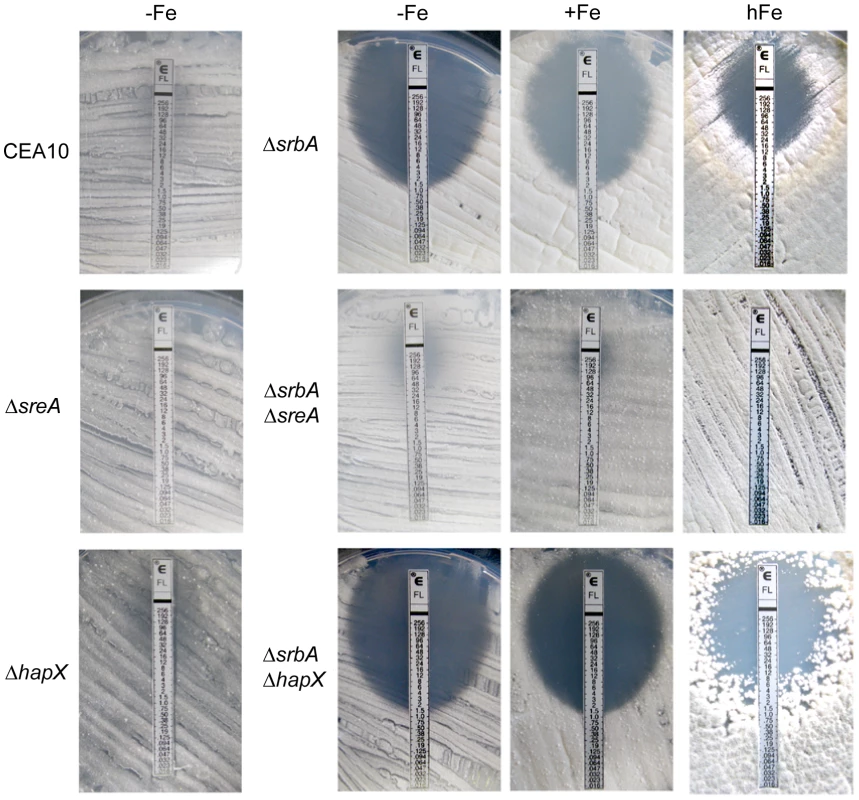
The direct binding of SrbA to the promoter of erg11A (also called cyp51A in A. fumigatus) led us to explore the potential mechanism behind this result. We thus examined transcript levels of erg11A, erg11B (cyp51B), erg25A, and srbA in response to varying levels of iron in wild-type and ΔsrbA. Addition of high iron to either wild-type or ΔsrbA significantly increased erg11A transcript levels (Figure 7A and 7B). As expected from the ChIP experiment, this effect on erg11A transcript was SrbA dependent (Figure 7A and 7B). Of note, erg11A is not contained on the microarray and thus erg11A transcript levels were not previously observed to be SrbA dependent. Consistent with the previous Northern blot experiments, loss of iron stimulated an increase in srbA transcript levels (Figure 7A). However, the effect of iron on erg25A transcripts was minimal, though as observed with the microarray data, erg25A transcript levels are SrbA dependent (Figure 7A and 7B). Next, we examined total ergosterol levels in wild-type, ΔsrbA, and ΔsrbAΔsreA strains (Figure 7C). Addition of high iron was able to increase total ergosterol levels in the ΔsrbA and ΔsrbAΔsreA backgrounds consistent with the increase in erg11A transcript levels. No difference in ergosterol levels was observed between the wild-type and ΔsreA strains (Figure 7C). These data, however, do not rule out the potential for increased enzyme efficiency in the presence of more available iron, or a restoration of membrane fluidity due to increases in ergosterol level that may affect triazole drug uptake. However, these data suggest that loss of iron homeostasis due to absence of SrbA affects ergosterol biosynthesis and triazole drug interactions in A. fumigatus.

As high iron levels or deletion of SreA were able to partially rescue the fluconazole susceptibility and decrease in ergosterol content in ΔsrbA, we hypothesized that these effects may also rescue the hypoxia growth defect of ΔsrbA. In further support of a link between hypoxia adaptation and iron homeostasis in A. fumigatus, supplementation of media with high iron concentrations plus inactivation of SreA partially rescues growth of ΔsrbA in hypoxia (Figure 8). This result can be explained by derepression of iron uptake due to SreA inactivation, which works best in the presence of high iron concentrations. Thus, in the absence of SreA, iron uptake is increased in ΔsrbA. HapX-deficiency had no effect on hypoxic growth and not surprisingly, is not transcriptionally induced in response to hypoxia. These data indicate that the hypoxic growth defect of ΔsrbA is at least partially explained by a defect in iron accumulation. In further support of this conclusion, susceptibility to cobalt chloride in the absence of SrbA is also rescued by further inactivation of SreA (Figure S4). Thus, the ability of either high iron or loss of SreA activity to partially rescue the fluconazole and hypoxia phenotypes of ΔsrbA strongly suggests that ΔsrbA cells are iron deficient. These results further support an important link between iron homeostasis and ergosterol biosynthesis as mediated by SrbA.
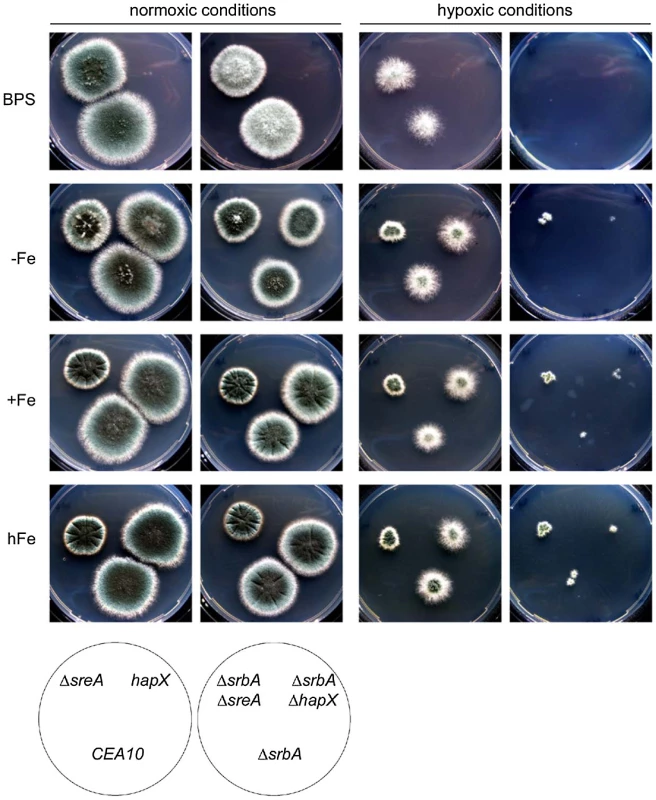
As the avirulence phenotype of ΔsrbA is hypothesized to at least partially be the result of its inability to grow in hypoxia, we next tested the ability of ΔsrbAΔsreA to cause disease in a chemotherapeutic murine model of invasive pulmonary aspergillosis. We have previously shown that ΔsrbA is fully avirulent in this murine model of IPA; however, inactivation of SreA in ΔsrbA was not able to rescue virulence in the absence of SrbA (Figure 9A). Histopathological examinations of wild-type, ΔsrbA, and ΔsrbAΔsreA strains revealed significant fungal growth and tissue necrosis in mice infected with CEA10 (Figure 9B). However, as previously reported, a significant reduction in ΔsrbA growth is observed in vivo and further inactivation of SreA did not visibly change the observed histopathology. As iron availability is extremely limited in vivo, and previous results demonstrating that A. fumigatus strains defective in siderophore biosynthesis have attenuated virulence, this result is likely not surprising and does not rule out a role for SrbA mediated iron homeostasis in the avirulence phenotype of ΔsrbA. Additional experiments examining the impact of loss of iron homeostasis in ΔsrbA on A. fumigatus virulence are ongoing.
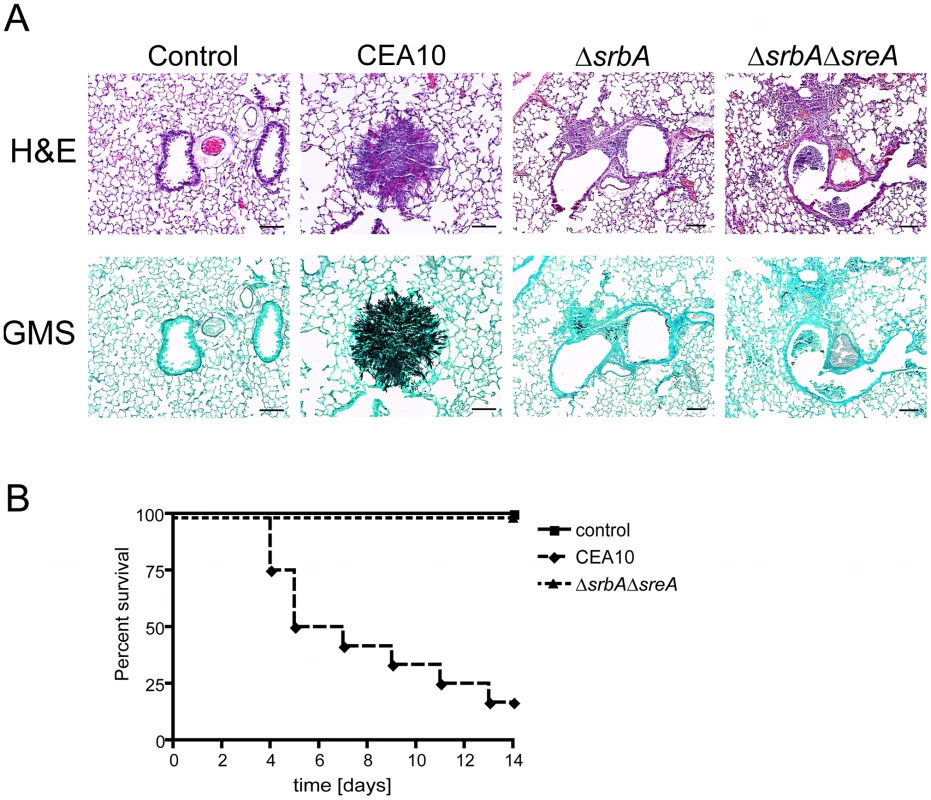
SrbA-deficiency alters the free amino acid pool composition in A. fumigatus during iron sufficiency and starvation
Iron starvation has previously been observed to cause a significant remodeling of the amino acid pool [2]. HapX, which is activated by iron-starvation, affects the amino acid composition during iron starvation but not during iron sufficiency and is crucial for coordination of the production of siderophores and their precursor ornithine. Given SrbA's role in mediating responses to low iron conditions and reduction of siderophore biosynthesis in the absence of SrbA, we next tested the hypothesis that loss of SrbA would also alter the amino acid pool of A. fumigatus. In support of this hypothesis, the transcriptome profile data suggest significant changes in the mRNA levels of genes involved in amino acid biosynthesis in the absence of SrbA upon exposure to hypoxia (Figure 10). In contrast to HapX-deficiency, SrbA-deficiency dramatically changed the composition of the amino acid pool during both iron-replete and depleted conditions (Table 2). Similar to HapX-deficiency, SrbA-deficiency decreased the cellular ornithine pool during iron starvation, which indicates together with the decrease in siderophore biosynthesis, that SrbA also plays a role in supply of the siderophore precursor ornithine. Thus, loss of siderophore biosynthesis in ΔsrbA may be due to regulation of critical precursor levels.
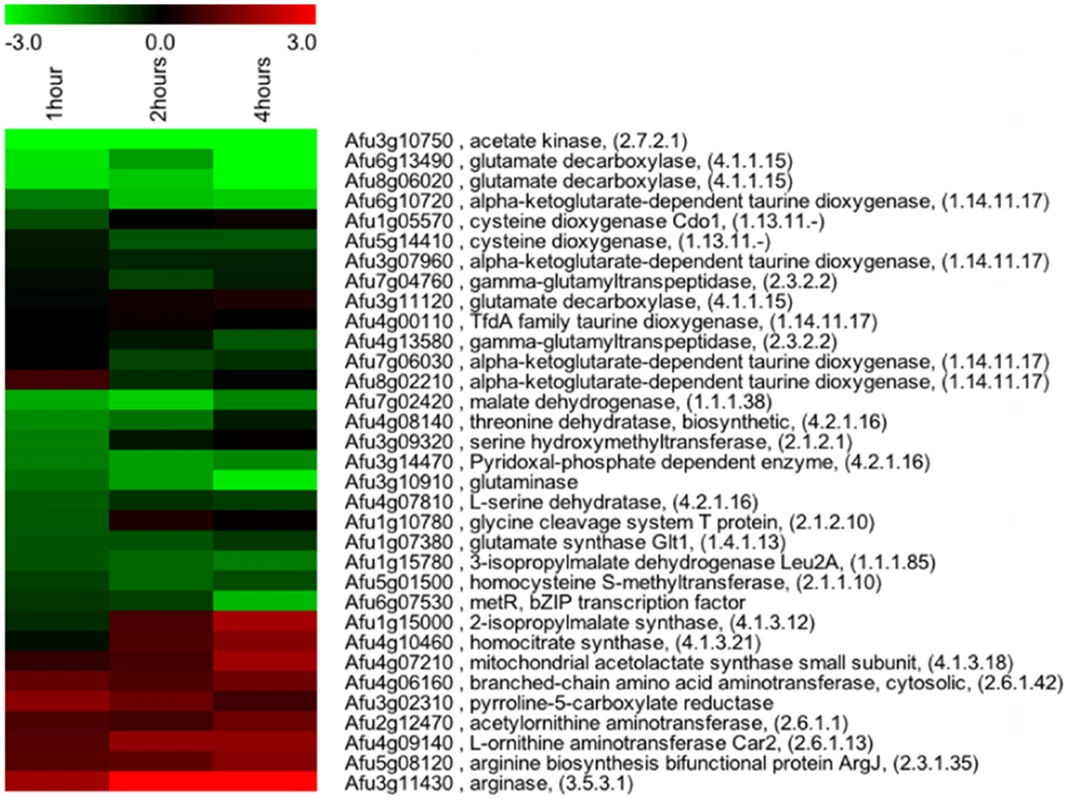
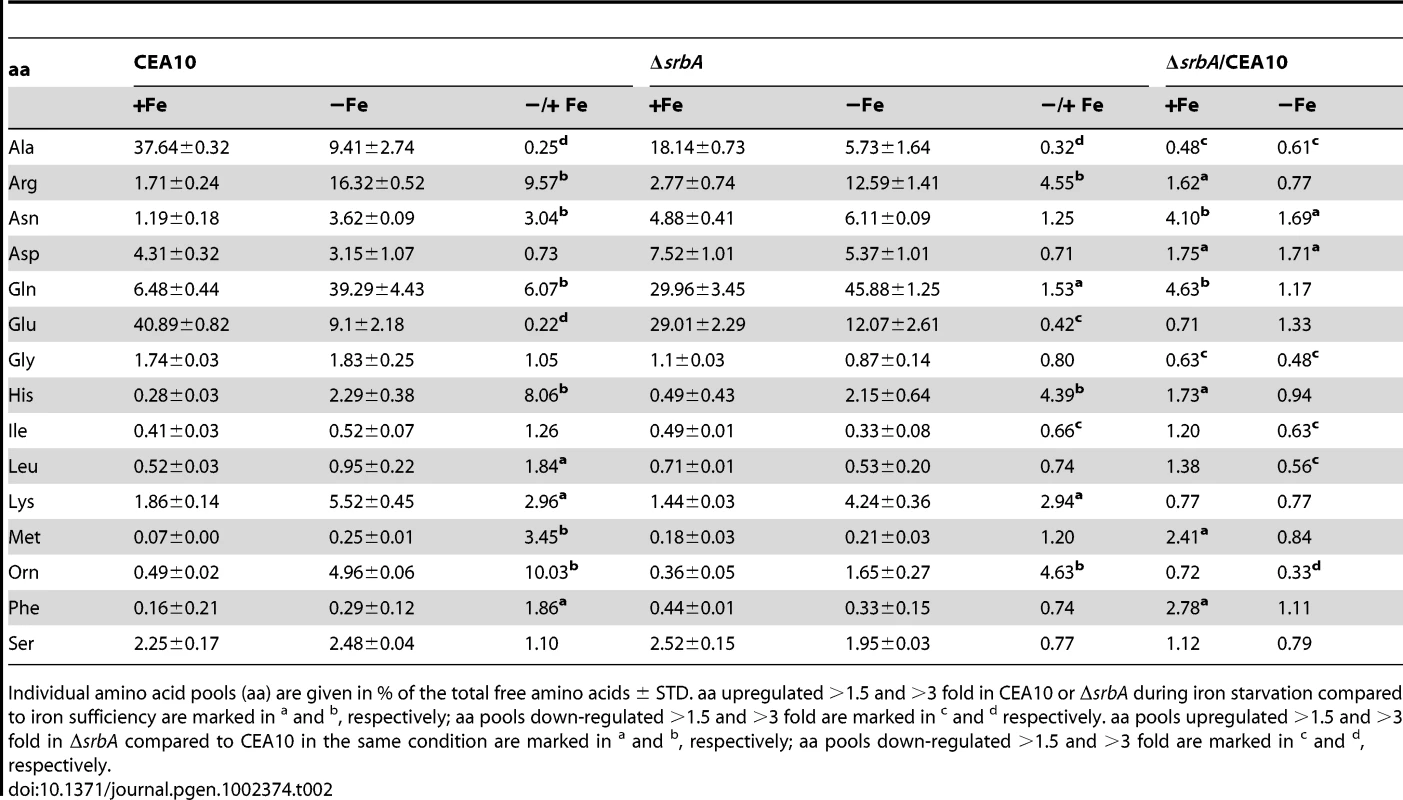
Discussion
Understanding the in vivo microenvironment conditions encountered by human pathogenic fungi is a promising line of inquiry for identifying novel therapeutic options for these frequently lethal infections. The importance of iron availability in host pathogen interactions is well established, and its role in invasive pulmonary aspergillosis is no exception. Previous studies have clearly demonstrated a critical role for iron acquisition mechanisms in fungal pathogenesis for A. fumigatus and other human pathogenic fungi [4], [5], [7], [8], [31], [32], [33], [34], [35], [36], [37], [38], [39], [40]. More recently, it has been hypothesized that adaptation to low oxygen microenvironments during fungal infection may also be a critical virulence attribute of human pathogenic fungi [17], [18], [19], [20], [22]. Support for this hypothesis partially stems from studies with fungal SREBP null mutants in C. neoformans and A. fumigatus that are incapable of growth in hypoxia and unable to cause lethal disease in murine models of fungal infections [17], [18], [19], [41], [42]. However, as SREBPs are transcription factors that regulate a significant number of genes in fungi, it is unclear if the hypoxia growth phenotype of fungal SREBP null mutants is the primary factor for loss of virulence in these mutants. Moreover, fungal SREBP mutants display increased susceptibility to the triazole class of antifungal drugs.
Thus, several key questions remain regarding the role of SrbA in fungal pathogenesis. Important questions include what is the mechanism behind the inability of SREBP null mutants to grow in hypoxia? Does this directly correlate with the avirulence of fungal mutants that lack SREBPs? And what is the mechanism behind the increased susceptibility to triazole drugs in the absence of SREBP? To begin to answer these potentially clinically relevant questions, we utilized whole-genome transcriptome analysis of A. fumigatus ΔsrbA exposed to hypoxia to identify SrbA downstream effectors. Here, we report that the A. fumigatus SREBP is a key positive regulator of iron homeostasis, particularly with regard to iron acquisition, that is essential for adaptation to hypoxia and low iron microenvironments. Although previous transcriptome profiling experiments with the C. neoformans SREBP null mutant also suggest a potential role for fungal SREBPs in iron acquisition [7], [17], here we definitively show that SREBP is required for adaptation to low iron conditions in A. fumigatus. We further observe that ΔsrbA cells are likely iron deficient and this partially explains the hypoxia growth and triazole susceptibility phenotypes of ΔsrbA. Importantly, SrbA's effect on iron homeostasis appears to be primarily independent of the well-studied iron transcriptional regulatory factors HapX and SreA.
SreA-deficiency in A. fumigatus and A. nidulans has been observed to partially derepress siderophore production and expression of respective genes involved in iron acquisition in iron replete conditions [15], [43]. Importantly, this result strongly suggested the existence of additional regulatory mechanisms involved in iron homeostasis in A. fumigatus. Next, the transcription factor HapX was demonstrated to be required not only for repression of iron-consuming pathways but also for activation of siderophore biosynthesis and uptake during iron starvation in A. nidulans and A. fumigatus [2], [44]. SreA and HapX are interconnected by a negative transcriptional feed back loop and simultaneous inactivation has been shown to be synthetically lethal in A. nidulans and A. fumigatus [2], [44]. Recently, the transcription factor AcuM, that is required for gluconeogenesis, was found to also activate siderophore biosynthesis most likely via repression of SreA in A. fumigatus but not A. nidulans [16]. Here we present data that strongly suggest that SrbA is another critical activator of high-affinity iron acquisition systems in A. fumigatus including the siderophore system and reductive iron assimilation [45].
Figure 11 depicts a proposed model linking SreA, HapX, and SrbA in regulation of iron acquisition and ergosterol biosynthesis. Clearly, additional studies are needed to definitively define the relationship between these three important transcriptional regulators of iron homeostasis. Future studies will also seek to incorporate AcuM into our model. Importantly, in response to hypoxia, our microarray data did not detect transcript changes in either HapX or AcuM in the SrbA null mutant. However, in iron depleted conditions, HapX transcript was clearly reduced in ΔsrbA, which indicates that SrbA may directly or indirectly regulate HapX transcript levels under these conditions. Deletion of HapX in ΔsrbA did increase the magnitude of reduction in siderophore levels, further suggesting a possible link between these two transcription factors that remains to be fully elucidated.
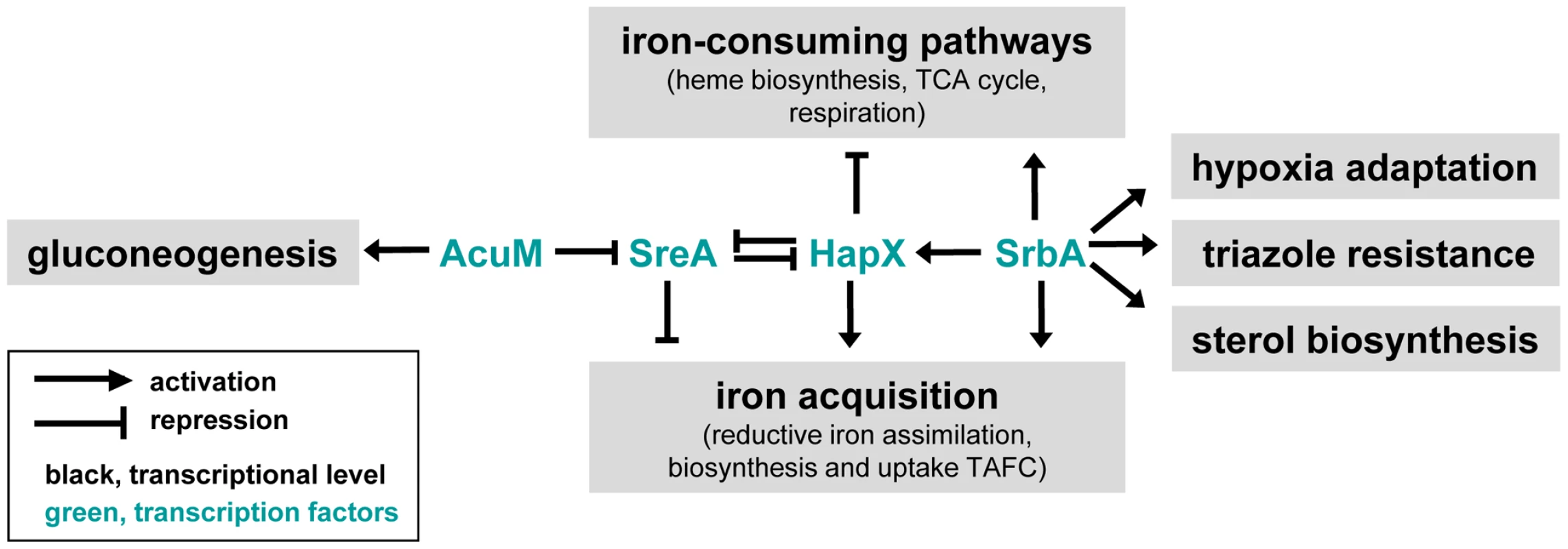
Defining a regulatory role for SrbA in iron acquisition is consistent with previous reports in other organisms that have linked SREBPs with regulation of sterol biosynthesis and adaptation to hypoxia. Previous studies have suggested a tight link between iron, oxygen and ergosterol biosynthesis in response to hypoxia in yeast. For example, in the model yeast S. cerevisiae, low iron conditions decrease the activity of the C4-sterol demethylase Erg25, and moreover, sterol synthesis in this organism requires heme [46]. While S. cerevisiae lacks an SREBP ortholog, S. pombe and C. neoformans Sre1 and A. fumigatus SrbA SREBPs appear to be key regulators of Erg25 and sterol biosynthesis [19], [30], [47] (Figure 1B, Figure 2, and Figure 5). Our A. fumigatus hypoxia transcriptome profiling data are also in agreement with similar studies in S. pombe and C. neoformans that demonstrate an increase in transcripts associated with heme, sterol biosynthesis, and iron uptake in response to hypoxia [17], [42], [48]. A recent proteomic analysis of A. fumigatus grown in a chemostat culture under hypoxia demonstrated that the cellular contents of heme and iron substantially increase in these conditions [49]. Thus, taken together, our results here and the results of prior seminal studies in yeast establish a tight link between iron, oxygen, ergosterol biosynthesis and fungal responses to hypoxia, which are mediated in part by SREBPs.
Further support for this conclusion comes from our results demonstrating that addition of high iron concentrations to ΔsrbA, or derepression of iron uptake by simulataneous deletion of SreA, is able to partially rescue the triazole susceptibility and hypoxia growth phenotypes of this fungal SREBP null mutant. As a major goal of our study was to better understand the mechanisms behind the clinically relevant antifungal drug and virulence phenotypes of the SrbA null mutant, these results are particularly significant. An important question is how increased iron availability rescues these important ΔsrbA phenotypes. To this end, the observed increase in total ergosterol levels in ΔsrbA and ΔsrbAΔsreA strains in high iron conditions suggest a direct SREBP mediated link between cellular iron levels and ergosterol biosynthesis. This was also reflected in the SrbA dependent decrease in erg11A (cyp51A) transcript levels that could also be partially rescued by high iron. This result may explain, at least partially, the restoration of fluconazole resistance and hypoxia growth of ΔsrbA under high iron conditions. It is important to note that A. fumigatus contains 2 functional 14α-demethylases (Erg11A/Cyp51A and Erg11B/Cyp51B) [50], [51]. Loss of Erg11A but not Erg11B function results in increased fluconazole susceptibility. Moreover, intriguingly, it was recently observed that fluconazole preferentially binds Erg11B, thus likely explaining A. fumigatus's inherent resistance to fluconazole [52].
In Candida albicans, a link between iron availability and fluconazole susceptibility has been suggested [53]. The authors observed a 30% reduction in ergosterol levels in low iron conditions and speculate that the increased fluconazole susceptibility in these conditions was due to a subsequent increase in membrane fluidity [53]. Thus, the partial rescue of fluconazole resistance in A. fumigatus ΔsrbA by high iron may in part be due to a reduction of membrane fluidity. In support of this hypothesis, ergosterol levels in ΔsrbA are approximately 50% less than wild-type, and increases in exogenous iron partially rescue this defect, which in theory could decrease membrane fluidity. How iron increases ergosterol levels is unknown, but it could be argued that the increased iron levels improve the efficiency of ergosterol biosynthetic enzymes whose levels appear to be reduced in the absence of SrbA. Both Erg11A and Erg25 require iron as a co-factor for their enzymatic functions. Thus, the observed increases in erg11A transcript levels in the presence of high iron could be due to a positive feedback loop activated by an increase in sterol intermediates that result from increased enzyme efficiency.
With regard to the potential link between hypoxia growth and fungal virulence, high iron conditions or concomitant inactivation of SreA could partially rescue the hypoxia growth phenotype of ΔsrbA, but not fungal virulence (Figure 9). Derepression of siderophore biosynthesis and iron uptake in ΔsrbA was not dramatic enough to rescue the virulence defect of ΔsrbA leaving the exact mechanism of SrbA's role in fungal virulence undefined. However, given that iron is a major limiting micronutrient in vivo, and that the effect of high iron on ΔsrbA growth was modest, this result is not surprising. As A. fumigatus mutants that lack siderophore biosynthesis also have attenuated virulence in vivo, it seems clear that SrbA's role in siderophore biosynthesis and iron uptake is at least partially related to the inability of ΔsrbA to cause lethal disease. Attempts to fully restore hypoxia growth of ΔsrbA via genetic manipulation of iron homeostasis and ergosterol biosynthesis pathways are currently underway.
In conclusion, our data suggest a new role for SREBPs in linking hypoxia adaptation, iron acquisition and ergosterol biosynthesis in fungi. We believe that untangling the web of SrbA regulated effectors will lead to a better understanding of SrbA's role in fungal pathogenesis and triazole drug susceptibility, which should provide a clearer picture regarding the potential of fungal SREBP modulation as a clinical therapeutic for human disesases caused by fungi. Thus, future studies will continue to seek to elucidate the genetic regulatory network mediated by SrbA in A. fumigatus and its relationship to fungal virulence and triazole drug interactions. It might also be intriguing to determine the extent to which SREBPs in other eukaryotic organisms are involved in iron homeostasis mechanisms and how this potential regulation is linked with sterol biosynthesis homeostasis especially in hypoxic stress environments.
Materials and Methods
Fungal strains and growth conditions
A. fumigatus strains were grown at 37°C in Aspergillus minimal medium (AMM) according to Pontecorvo et al. [54] containing 1% glucose as carbon source and 20 mM glutamine as nitrogen source or glucose minimal medium (GMM) with 1% glucose as carbon source as previously described [19]. Iron-repleted media (+Fe) were supplemented with 30 µM FeSO4 and high iron media contained 1.5 mM, 3.0 mM, 5 mM or 10 mM FeSO4, respectively. Media used and concentrations of key elements are denoted according to the respective experiments. For iron depleted conditions (−Fe) addition of iron was omitted. For hypoxic conditions, 13.45 g AneroGen™ was used or an INVIVO2 Hypoxia Chamber (Ruskinn) set at 1% O2, 5% CO2, 94% N2. For liquid growth assays, 108 conidia were inoculated in 200 ml minimal medium.
Transcriptome analysis
Nucleic acid extraction
Tissue was resuspended in 1 ml of Trizol reagent followed by a five minute incubation at RT. 0.2 volumes of chloroform was added, followed by a short vortex at low speed followed by 2 minute incubation at RT. Tubes were centrifuged at 16,000×g for 15 min at 4°C. The clear upper layer was pipeted into new tube and an equal volume of 80% EtOH was added. Samples were mixed well and applied to RNeasy spin column (Qiagen RNA kit) following manufacturer's instructions. RNA was eluted with 100 µL of RNase free water. Column incubated for one minute before centrifugation to elute maximum amount of RNA.
cDNA preparation and probe labeling
10 µg of total RNA was used for cDNA synthesis using SuperScriptIII (Invitrogen), following the “Microbial RNA aminoallyl labeling for microarrays” (SOP# M007 Rev. 2) protocol detailed at http://pfgrc.jcvi.org/index.php/microarray/protocols.html. Briefly, samples were RNaseH treated and the cDNA concentration was checked on a Nanodrop 1000. cDNA was purified with Qiagen QIAquick PCR purification kit. Concentration was rechecked with Nanodrop and samples were dried completely with Eppendorf speed-vac. Pellet was resuspended with 4.5 µL of fresh 0.1 M Na2CO3 buffer solution. 4.5 µL of Cy3 or Cy5 dye was added to appropriate tubes, and coupling was completed. Uncoupled dye was removed with NaOAc-modified QIAquick PCR cleanup. Dye ratio was calculated with Nanodrop. The two differentially labeled probes (Cy3 vs. Cy5) that were hybridized to the same microarray slide are mixed with equal cDNA volumes. The Cy3/Cy5 probe mixture was dried to completion in Eppendorf speed-vac. Resulting pellet was suspended in 10 µL of dH2O.
Microarray hybridization
Spotted arrays (Aspergillus fumigatus Af293, version 3) from the pathogen functional genomics resource center at JCVI were used for the entire experiment (http://pfgrc.jcvi.org/index.php/microarray/array_description/aspergillus_fumigatus/version3.html). The protocol “Microbial Hybridization of labeled probes” (SOP# M008 Rev 2.1) can be found at: http://pfgrc.jcvi.org/index.php/microarray/protocols.html. Briefly, the slides were soaked in sterile-filtered pre-hybridization solution (5×SSC, 1%BSA, 0.2%SDS) for two hours, washed and dried by centrifugation in mini slide spinner (LabNet) prior to hybridization. 45 µL of hybridization mixture (50% formamide, 5×SSC, 0.1%SDS, 0.001 M DTT) and 6 µL of salmon sperm DNA were added to probe. Lifter slip (Erie Scientific) was washed in 100% EtOH and dried. The slide and lifter slip were placed in hybridization chamber (Corning) and 60 µL of probe mixture was pipeted under lifter slip. Chambers were sealed and incubated in 42°C water bath for 18 hours. Slides were washed twice in low stringency buffer (2×SSC, 0.2% SDS, 0.02 M DTT), twice in medium stringency buffer (0.1× SSC, 0.1% SDS, 0.02 M DTT), twice in high stringency buffer (0.1× SSC, 0.02 M DTT), and a final wash with dH2O and 0.02 M DTT. Slides were dried completely in mini slide spinner.
Image processing
Slides were scanned with GenePix 4000B dual wavelength scanner (Axon Instruments, Molecular Devices Co.), adjusting PMT gain ratio to ∼1.0, 100% laser power, and pixel size of 10. The resulting images were checked by eye for misaligned regions or false signals using GenePixPro 6.0 (Axon Instruments, Molecular Devices Co.). A GenePix report file was generated with raw data reads for each spot. These raw files are available at EMBL MIAMExpress website (http://www.ebi.ac.uk/arrayexpress/), accession number E-MEXP-3172.
Data processing
Data were processed using TM4 software and protocol recommendations for microarray analysis (http://www.tm4.org/). Briefly, GenePix files were converted to MeV files using ExpressConverter 2.1. MeV files were analyzed with MIDAS 2.21 to normalize data, according to the recommended settings from TM4. Flip-dye pairs were read into MIDAS using a generous setting for one bad channel, and A and B channel flag check selected. LOWESS was used to minimize effect of intensity dependent bias, with default settings. Standard deviation regularization was used to minimize the effect of slide printing errors, with Cy3 as the reference. Flip-dye pairs were then checked for consistency and merged into a single MeV file. Biological replicates were then averaged to a single value for each gene and timepoint. This file is also available at MIAMExpress (http://www.ebi.ac.uk/arrayexpress/). Pathway analysis was then completed using gene set enrichment analysis (GSEA).
Chromatin immunoprecipitation and ChIP-qPCR
ChIP was performed after four hours exposure to hypoxia using methods in Kim et al. 2010 [55]. Briefly, cells were exposed to 1% formaldehyde to crosslink proteins to DNA, nuclei were isolated with nuclei isolation kit (Sigma) and then lysed and resulting DNA sonicated to 400–700 bp fragments. ChIP was performed with 1 µg of polyclonal antibody to SrbA (amino acids 1–275) on Protein A DynaMag beads (Invitrogen), in both wild-type and ΔsrbA strains. Negative control for ChIP was the IgG mouse antibody (Invitrogen). DNA quantity was assessed with Qubit 2.0 Fluorometer, using the high sensitivity dsDNA assay (Invitrogen). All ChIP samples were diluted 10 fold for PCR. 1 µl of template was used in a 10 µl total volume reaction using Promega 2× GoTaq qPCR master mix and 0.4 µM of each primer. Realtime PCR was performed with 40 cycles of 95°C for 15 s and 60°C for 30 s on Mastercycler ep realplex PCR machine. PCR was performed in duplicate for two separate ChIP experiments using primers designed for regions identified as enriched in preliminary ChIP-SEQ analysis (Barker et al. unpublished). Three genes were chosen from this analysis as positive for enrichment (sit1, erg11A and erg25A) and one was chosen as negative for enrichment (sidA). Percent input method was used to calculate the signal of enrichment of the promoter region for each gene (http://cshprotocols.cshlp.org/cgi/content/full/2009/9/pdb.prot5279 and Invitrogen website). Briefly, 100*(2(InputCt-ChIPCt)) was calculated for each reaction and the average and standard deviation calculated from these values. No correction for adjusted input was necessary as both templates were diluted equally prior to PCR. Oligonucleotides used for ChIP analysis are provided in Datasets S1 and S2.
Quantitative real-time PCR
qRT-PCR to measure transcript abundance was performed as we have previously described [56], [57].
Manipulation of nucleic acids and Northern analysis
Standard molecular techniques were performed using the pGEM-T vector system (Promega) and the bacterial strain Escherichia coli DH5α cultivated in LB medium (1% bacto-tryptone, 0.5% yeast extract, 1% NaCl, pH 7.5) as we have previously described [2], [15]. RNA was isolated using TRI reagent (Sigma-Aldrich). 10 µg of total RNA were used for electrophoresis on 1.2% agarose −2.2 M formaldehyde gels and blotted onto Hybond N membranes (Amersham Biosciences). Probes used in this study were generated by PCR with the digoxigenin labeling system (Roche Molecular Biochemicals); Oligonucleotides used for Northern analysis are provided in Dataset S3.
Deletion of hapX and sreA in ΔsrbA and CEA10
Deletion of sreA and hapX in CEA10 or ΔsrbA backgrounds was carried out as described previously for A. fumigatus ATCC46645 using the same deletion constructs [2], [15].
Oligonucleotides used for deletions are provided in Dataset S4.
Analysis of siderophore production and free amino acid pools
Isolation and analysis of extra- and intracellular siderophores from culture supernatants and cellular extracts, respectively, was carried out as described previously [58], [59]. Quantification of free amino acid pools was carried out as described previously [60].
Susceptibility testing to fluconazole and total ergosterol content measurements
E-test strips (AB bioMérieux), plastic strips impregnated with a gradient of fluconazole were used per manufacturers' instructions. Each strip was placed onto a AMM agar plate without iron or supplemented with 30 µM or 10 mM FeSO4 containing a lawn of conidia of the respective strain and growth inhibition was measured after 24 and 48 h by direct observation of the plates at 37°C. No difference in results was observed between 24 and 48 hours. Total ergosterol content was measured as previously described [61]. Total ergosterol content results are the mean and standard deviation from 2 biological replicates with 6 total technical replicates for each strain.
Murine virulence assay of invasive pulmonary aspergillosis
6 to 8 weeks old outbred CD-1 mice were immunosuppressed with intraperitoneal (i.p.) injections of cyclophosphamide at 150 mg/kg 2 days prior to inoculation and 40 mg/kg Kenalog injected subcutaneously (s.c.) 1 day prior to inoculation. Repeat injections were given on day 3 post inoculation with cyclophosphamide (150 mg/kg i.p.) and on day 6 post inoculation with Kenalog (40 mg/kg s.c.). Mice were housed six per cage and had access to food and water ad libitum. Twelve mice per A. fumigatus strain (CEA10 and ΔsrbAΔsreA) were inoculated intranasally with 1×106 conidia/40 µl following brief isofluorane inhalation. Mock control mice were inoculated with sterile 0.01% Tween 80. Mice were monitored twice daily over a time period of 14 days. Any animals showing distress were immediately sacrificed and recorded as deaths within 24 hrs. No mock infected animals perished during the time course of the experiment. All experiments were approved by the Montana State University IACUC and adhere to NIH policies on animal welfare.
Ethics statement
This study was carried out in strict accordance with the recommendations in the Guide for the Care and Use of Laboratory Animals of the National Institutes of Health. The animal experimental protocol was approved by the Institutional Animal Care and Use Committee (IACUC) at Montana State University (Federal-Wide Assurance Number: A3637-01).
Histopathology
For histopathology, five CD-1 mice per A. fumigatus strain (CEA10, ΔsrbA, ΔsrbAΔsreA) were immunosuppressed and inoculated as described above. On day 4 post A. fumigatus challenge, mice were sacrificed by pentobarbital anesthesia (100 µg/g body weight) followed by exsanguinations. Lungs were removed immediately, fixed in 10% phosphate-buffered formalin, embedded in paraffin, sectioned at 5 µm, and stained with hematoxylin, and eosin (H&E) or Gomori methenamine silver (GMS) by using standard histological techniques. Microscopic examinations were performed on a Nikon Eclipse 80i microscope and imaging system (Nikon Instruments Inc., Melville, NY, USA).
Supporting Information
Zdroje
1. KornitzerD 2009 Fungal mechanisms for host iron acquisition. Current opinion in microbiology 12 377 383
2. SchrettlMBeckmannNVargaJHeinekampTJacobsenID 2010 HapX-mediated adaption to iron starvation is crucial for virulence of Aspergillus fumigatus. PLoS Pathog 6 e1001124 doi:10.1371/journal.ppat.1001124
3. SchrettlMIbrahim-GranetODroinSHuerreMLatgeJP 2010 The crucial role of the Aspergillus fumigatus siderophore system in interaction with alveolar macrophages. Microbes and infection/Institut Pasteur 12 1035 1041
4. SchrettlMBignellEKraglCSabihaYLossO 2007 Distinct roles for intra- and extracellular siderophores during Aspergillus fumigatus infection. PLoS Pathog 3 e128 doi:10.1371/journal.ppat.0030128
5. SchrettlMBignellEKraglCJoechlCRogersT 2004 Siderophore biosynthesis but not reductive iron assimilation is essential for Aspergillus fumigatus virulence. The Journal of experimental medicine 200 1213 1219
6. HissenAHChowJMPintoLJMooreMM 2004 Survival of Aspergillus fumigatus in serum involves removal of iron from transferrin: the role of siderophores. Infection and immunity 72 1402 1408
7. JungWHKronstadJW 2008 Iron and fungal pathogenesis: a case study with Cryptococcus neoformans. Cellular microbiology 10 277 284
8. JungWHShamAWhiteRKronstadJW 2006 Iron regulation of the major virulence factors in the AIDS-associated pathogen Cryptococcus neoformans. PLoS Biol 4 e410 doi:10.1371/journal.pbio.0040410
9. MendelGA 1961 Studies on iron absorption. I. The relationships between the rate of erythropoiesis, hypoxia and iron absorption. Blood 18 727 736
10. RolfsAKvietikovaIGassmannMWengerRH 1997 Oxygen-regulated transferrin expression is mediated by hypoxia-inducible factor-1. The Journal of biological chemistry 272 20055 20062
11. MukhopadhyayCKMazumderBFoxPL 2000 Role of hypoxia-inducible factor-1 in transcriptional activation of ceruloplasmin by iron deficiency. The Journal of biological chemistry 275 21048 21054
12. LeePJJiangBHChinBYIyerNVAlamJ 1997 Hypoxia-inducible factor-1 mediates transcriptional activation of the heme oxygenase-1 gene in response to hypoxia. The Journal of biological chemistry 272 5375 5381
13. YoonDPastoreYDDivokyVLiuEMlodnickaAE 2006 Hypoxia-inducible factor-1 deficiency results in dysregulated erythropoiesis signaling and iron homeostasis in mouse development. The Journal of biological chemistry 281 25703 25711
14. PeyssonnauxCNizetVJohnsonRS 2008 Role of the hypoxia inducible factors HIF in iron metabolism. Cell cycle 7 28 32
15. SchrettlMKimHSEisendleMKraglCNiermanWC 2008 SreA-mediated iron regulation in Aspergillus fumigatus. Molecular microbiology 70 27 43
16. LiuHGravelatFNChiangLYChenDVanierG 2010 Aspergillus fumigatus AcuM regulates both iron acquisition and gluconeogenesis. Molecular microbiology 78 1038 1054
17. ChangYCBienCMLeeHEspenshadePJKwon-ChungKJ 2007 Sre1p, a regulator of oxygen sensing and sterol homeostasis, is required for virulence in Cryptococcus neoformans. Mol Microbiol 64 614 629
18. ChunCDLiuOWMadhaniHD 2007 A Link between virulence and homeostatic responses to hypoxia during infection by the human fungal pathogen Cryptococcus neoformans. PLoS Pathog 3 e22 doi:10.1371/journal.ppat.0030022
19. WillgerSDPuttikamonkulSKimKHBurrittJBGrahlN 2008 A sterol-regulatory element binding protein is required for cell polarity, hypoxia adaptation, azole drug resistance, and virulence in Aspergillus fumigatus. PLoS Pathog 4 e1000200 doi:10.1371/journal.ppat.1000200
20. GrahlNCramerRAJr 2009 Regulation of hypoxia adaptation: an overlooked virulence attribute of pathogenic fungi? Med Mycol 1 16
21. WezenskySJCramerRA 2010 Implications of hypoxic microenvironments during invasive aspergillosis. Med Mycol
22. ErnstJFTielkerD 2009 Responses to hypoxia in fungal pathogens. Cellular microbiology 11 183 190
23. EspenshadePJ 2006 SREBPs: sterol-regulated transcription factors. Journal of cell science 119 973 976
24. RawsonRB 2003 Control of lipid metabolism by regulated intramembrane proteolysis of sterol regulatory element binding proteins (SREBPs). Biochem Soc Symp 221 231
25. RawsonRB 2003 The SREBP pathway–insights from Insigs and insects. Nat Rev Mol Cell Biol 4 631 640
26. NomuraTHorikawaMShimamuraSHashimotoTSakamotoK 2010 Fat accumulation in Caenorhabditis elegans is mediated by SREBP homolog SBP-1. Genes & nutrition 5 17 27
27. TontonozPKimJBGravesRASpiegelmanBM 1993 ADD1: a novel helix-loop-helix transcription factor associated with adipocyte determination and differentiation. Molecular and cellular biology 13 4753 4759
28. YokoyamaCWangXBriggsMRAdmonAWuJ 1993 SREBP-1, a basic-helix-loop-helix-leucine zipper protein that controls transcription of the low density lipoprotein receptor gene. Cell 75 187 197
29. ToddBLStewartEVBurgJSHughesALEspenshadePJ 2006 Sterol regulatory element binding protein is a principal regulator of anaerobic gene expression in fission yeast. Mol Cell Biol 26 2817 2831
30. HughesALToddBLEspenshadePJ 2005 SREBP pathway responds to sterols and functions as an oxygen sensor in fission yeast. Cell 120 831 842
31. LianTSimmerMID'SouzaCASteenBRZuyderduynSD 2005 Iron-regulated transcription and capsule formation in the fungal pathogen Cryptococcus neoformans. Molecular microbiology 55 1452 1472
32. JungWHShamALianTSinghAKosmanDJ 2008 Iron source preference and regulation of iron uptake in Cryptococcus neoformans. PLoS Pathog 4 e45 doi:10.1371/journal.ppat.0040045
33. JungWHSaikiaSHuGWangJFungCK 2010 HapX positively and negatively regulates the transcriptional response to iron deprivation in Cryptococcus neoformans. PLoS Pathog 6 e1001209 doi:10.1371/journal.ppat.1001209
34. AlmeidaRSWilsonDHubeB 2009 Candida albicans iron acquisition within the host. FEMS yeast research 9 1000 1012
35. HeymannPGeradsMSchallerMDromerFWinkelmannG 2002 The siderophore iron transporter of Candida albicans (Sit1p/Arn1p) mediates uptake of ferrichrome-type siderophores and is required for epithelial invasion. Infection and immunity 70 5246 5255
36. RamananNWangY 2000 A high-affinity iron permease essential for Candida albicans virulence. Science 288 1062 1064
37. SweetSPDouglasLJ 1991 Effect of iron deprivation on surface composition and virulence determinants of Candida albicans. Journal of general microbiology 137 859 865
38. TattersallP 1990 Iron deficiency and candida infection. The Practitioner 234 326
39. KirkpatrickCHGreenIRichRRSchadeAL 1971 Inhibition of growth of Candida albicans by iron-unsaturated lactoferrin: relation to host-defense mechanisms in chronic mucocutaneous candidiasis. The Journal of infectious diseases 124 539 544
40. EsterlyNBBrammerSRCrounseRG 1967 The relationship of transferrin and iron to serum inhibition of Candida albicans. The Journal of investigative dermatology 49 437 442
41. BienCMChangYCNesWDKwon-ChungKJEspenshadePJ 2009 Cryptococcus neoformans Site-2 protease is required for virulence and survival in the presence of azole drugs. Molecular microbiology 74 672 690
42. ChunCDLiuOWMadhaniHD 2007 A link between virulence and homeostatic responses to hypoxia during infection by the human fungal pathogen Cryptococcus neoformans. PLoS Pathog 3 e22 doi:10.1371/journal.ppat.0030022
43. HaasHZadraIStofflerGAngermayrK 1999 The Aspergillus nidulans GATA factor SREA is involved in regulation of siderophore biosynthesis and control of iron uptake. The Journal of biological chemistry 274 4613 4619
44. HortschanskyPEisendleMAl-AbdallahQSchmidtADBergmannS 2007 Interaction of HapX with the CCAAT-binding complex–a novel mechanism of gene regulation by iron. The EMBO journal 26 3157 3168
45. WallnerABlatzerMSchrettlMSargBLindnerH 2009 Ferricrocin, a siderophore involved in intra- and transcellular iron distribution in Aspergillus fumigatus. Applied and environmental microbiology 75 4194 4196
46. KaplanJMcVey WardDCrispRJPhilpottCC 2006 Iron-dependent metabolic remodeling in S. cerevisiae. Biochimica et biophysica acta 1763 646 651
47. HughesALLeeCYBienCMEspenshadePJ 2007 4-Methyl sterols regulate fission yeast SREBP-Scap under low oxygen and cell stress. J Biol Chem 282 24388 24396
48. ToddBLStewartEVBurgJSHughesALEspenshadePJ 2006 Sterol regulatory element binding protein is a principal regulator of anaerobic gene expression in fission yeast. Molecular and cellular biology 26 2817 2831
49. VodischMScherlachKWinklerRHertweckCBraunHP 2011 Analysis of the Aspergillus fumigatus Proteome Reveals Metabolic Changes and the Activation of the Pseurotin A Biosynthesis Gene Cluster in Response to Hypoxia. Journal of proteome research
50. MelladoEDiaz-GuerraTMCuenca-EstrellaMRodriguez-TudelaJL 2001 Identification of two different 14-alpha sterol demethylase-related genes (cyp51A and cyp51B) in Aspergillus fumigatus and other Aspergillus species. Journal of clinical microbiology 39 2431 2438
51. MelladoEGarcia-EffronGBuitragoMJAlcazar-FuoliLCuenca-EstrellaM 2005 Targeted gene disruption of the 14-alpha sterol demethylase (cyp51A) in Aspergillus fumigatus and its role in azole drug susceptibility. Antimicrobial agents and chemotherapy 49 2536 2538
52. WarrilowAGMeloNMartelCMParkerJENesWD 2010 Expression, purification, and characterization of Aspergillus fumigatus sterol 14-alpha demethylase (CYP51) isoenzymes A and B. Antimicrobial agents and chemotherapy 54 4225 4234
53. PrasadTChandraAMukhopadhyayCKPrasadR 2006 Unexpected link between iron and drug resistance of Candida spp.: iron depletion enhances membrane fluidity and drug diffusion, leading to drug-susceptible cells. Antimicrobial agents and chemotherapy 50 3597 3606
54. PontecorvoGRoperJAHemmonsLMMacdonaldKDBuftonAW 1953 The genetics of Aspergillus nidulans. Adv Genet 5 141 238
55. KimSHuJOhYParkJChoiJ 2010 Combining ChIP-chip and expression profiling to model the MoCRZ1 mediated circuit for Ca/calcineurin signaling in the rice blast fungus. PLoS Pathog 6 e1000909 doi:10.1371/journal.ppat.1000909
56. GrahlNPuttikamonkulSMacdonaldJMGamcsikMPNgoLY 2011 In vivo hypoxia and a fungal alcohol dehydrogenase influence the pathogenesis of invasive pulmonary aspergillosis. PLoS Pathog 7 e1002145 doi:10.1371/journal.ppat.1002145
57. PuttikamonkulSWillgerSDGrahlNPerfectJRMovahedN 2010 Trehalose 6-phosphate phosphatase is required for cell wall integrity and fungal virulence but not trehalose biosynthesis in the human fungal pathogen Aspergillus fumigatus. Mol Microbiol 77 891 911
58. ObereggerHSchoeserMZadraIAbtBHaasH 2001 SREA is involved in regulation of siderophore biosynthesis, utilization and uptake in Aspergillus nidulans. Molecular microbiology 41 1077 1089
59. Konetschny-RappSHuschkaHGWinkelmannGJungG 1988 High-performance liquid chromatography of siderophores from fungi. Biology of metals 1 9 17
60. BergerHBasheerABockSReyes-DominguezYDalikT 2008 Dissecting individual steps of nitrogen transcription factor cooperation in the Aspergillus nidulans nitrate cluster. Molecular microbiology 69 1385 1398
61. Alcazar-FuoliLMelladoEGarcia-EffronGLopezJFGrimaltJO 2008 Ergosterol biosynthesis pathway in Aspergillus fumigatus. Steroids 73 339 347
Štítky
Genetika Reprodukční medicínaČlánek vyšel v časopise
PLOS Genetics
2011 Číslo 12
- Primární hyperoxalurie – aktuální možnosti diagnostiky a léčby
- Mateřský haplotyp KIR ovlivňuje porodnost živých dětí po transferu dvou embryí v rámci fertilizace in vitro u pacientek s opakujícími se samovolnými potraty nebo poruchami implantace
- Intrauterinní inseminace a její úspěšnost
- Akutní intermitentní porfyrie
- Srdeční frekvence embrya může být faktorem užitečným v předpovídání výsledku IVF
Nejčtenější v tomto čísle
- Targeted Proteolysis of Plectin Isoform 1a Accounts for Hemidesmosome Dysfunction in Mice Mimicking the Dominant Skin Blistering Disease EBS-Ogna
- The RNA Silencing Enzyme RNA Polymerase V Is Required for Plant Immunity
- The FGFR4-G388R Polymorphism Promotes Mitochondrial STAT3 Serine Phosphorylation to Facilitate Pituitary Growth Hormone Cell Tumorigenesis
- Hierarchical Generalized Linear Models for Multiple Groups of Rare and Common Variants: Jointly Estimating Group and Individual-Variant Effects
